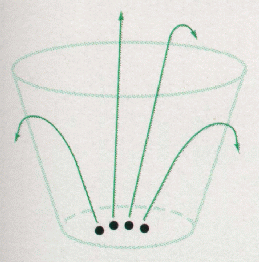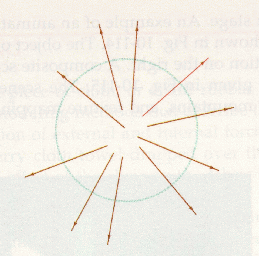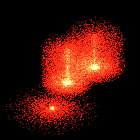Particle Systems
Allow us to describe natural or irregular shaped objects which are flowing or fluid-like, particular objects which are changing over time.
We can model objects, like grass, which are not actually composed of particles but which are fluid in form.
We can also model objects, like waterfalls and fireworks, which are actual physical processes that we can attempt to model through particles.
  |
Collection of particles - A particle system is composed of one or more individual particles.Stochastically defined attributes : some type of random elementPosition, Velocity (speed and direction), Color, Lifetime, Age, Shape, Size, TransparencyParticle Life CycleGeneration - Particles in the system are generated randomly within a predetermined location of the fuzzy objectParticle Dynamics - The attributes of each of the particles may vary over time. (particle position is going to be dependent on previous particle position and velocity as well as timeExtinction - Each particle has two attributes dealing with length of existence: age and lifetime.Rendering |
Example : 
Extract from : Particle Systems by Allen Martin
The term particle system is loosely defined in computer graphics. It has been used to describe modeling techniques, rendering techniques, and even types of animation. In fact, the definition of a particle system seems to depend on the application that it is being used for. The criteria that hold true for all particle systems are the following:
Collection of particles - A particle system is composed of one or more individual particles. Each of these particles has attributes that directly or indirectly effect the behavior of the particle or ultimately how and where the particle is rendered. Often, particles are graphical primitives such as points or lines, but they are not limited to this. Particle systems have also been used to represent complex group dynamics such as flocking birds.
Stochastically defined attributes - The other common characteristic of all particle systems is the introduction of some type of random element. This random element can be used to control the particle attributes such as position, velocity and color. Usually the random element is controlled by some type of predefined stochastic limits, such as bounds, variance, or type of distribution.
Each object in Reeves particle system had the following
attributes:
Position
Velocity (speed and direction)
Color
Lifetime
Age
Shape
Size
Transparency
Particle Life Cycle
Each particle goes through three distinct phases in the particle system: generation,
dynamics, and death. These phases are described in more detail here:
Generation - Particles in the system are generated randomly within a predetermined
location of the fuzzy object. This space is termed the generation shape of the
fuzzy object, and this generation shape may change over time. Each of the above
mentioned attribute is given an initial value. These initial values may be fixed
or may be determined by a stochastic process.
Particle Dynamics - The attributes of each of the particles may vary over time.
For example, the color of a particle in an explosion may get darker as it gets
further from the center of the explosion, indicating that it is cooling off.
In general, each of the particle attributes can be specified by a parametric
equation with time as the parameter. Particle attributes can be functions of
both time and other particle attributes. For example, particle position is going
to be dependent on previous particle position and velocity as well as time.
Extinction - Each particle has two attributes dealing with length of existence:
age and lifetime. Age is the time that the particle has been alive (measured
in frames), this value is always initialized to 0 when the particle is created.
Lifetime is the maximum amount of time that the particle can live (measured
in frames). When the particle age matches it's lifetime it is destroyed. In
addition there may be other criteria for terminating a particle prematurely:
Running out of bounds - If a particle moves out of the viewing area and will
not reenter it, then there is no reason to keep the particle active.
Hitting the ground - It may be assumed that particles that run into the ground
burn out and can no longer be seen.
Some attribute reaches a threshold - For example, if the particle color is so
close to black that it will not contribute any color to the final image, then
it can be safely destroyed.
Rendering
When rendering this system of thousands of particles, some assumptions have
to be made to simplify the process. First, each particle is rendered to a small
graphical primitive (blob). Particles that map to the same pixels in the image
are additive - the color of a pixel is simply the sum of the color values of
all the particles that map to it. Because of this assumption, no hidden surface
algorithms are needed to render the image, the particles are simply rendered
in order. Effects like temporal ant-aliasing (motion blur) are made simple by
the particle system process. The position and velocity are known for each particle.
By rendering a particle as a streak, motion blur can be achieved.